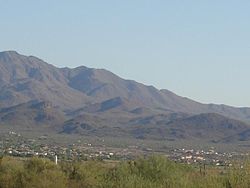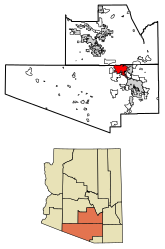|
Marana, Arizona
Marana (/məˈræ.nə/) is a town that mostly lies in Pima County with a small portion in Pinal County, in the U.S. state of Arizona.[3][4] It is located northwest of Tucson, Arizona. As of the 2020 census, the population of the town was 51,908.[5] HistoryArchaeologists found evidence of about 4,200 years of continuous human settlement in the vicinity of Marana and in the middle of Santa Cruz Valley. Many significant archaeological sites have been found near Marana.
Spanish colonists began to inhabit this area in the 17th and 18th centuries. Over time they intermarried with Native Americans, and a class of mestizo settlers also developed. From the early years, mining and ranching were the chief economic activities. The area became part of the independent Mexican Empire established in 1821 (soon replaced by the Republic of Mexico). US territoryMore than two decades later, the United States acquired this territory as part of the Gadsden Purchase; it was not part of the Mexican Cession following the defeat in the Mexican-American War, ending in 1848. 20th-century pioneersAccording to historian David Leighton, Charles B. Anway was the first member of the Anway family in the Tucson area;[citation needed] from the eastern United States, he came because the dry mountain air was thought to be beneficial for people suffering from tuberculosis, as he was. Antibiotics were not yet in general use to treat this disease, which had a high mortality rate and no known cure. In 1919, his brother William and his two children, Louis and Ila, arrived in town, but they decided to settle in an area northwest of Tucson called Postvale, Arizona. In 1920, the longtime widower William Anway married Orpha Ralston. She had been a member for many years of the Postvale Co-operative Women's Club. This group lobbied to have the local post office renamed from Postvale to Marana; in time, the town was also named Marana.[7] Marana did not become developed primarily as an agricultural center until after World War I. It has produced the commodity crops cotton, wheat, barley, alfalfa, and pecans. During World War II, the Army built facilities in Marana to support the military effort, including the Marana Airfield (1942–45, now the Pinal Airpark). It became the largest pilot-training center in the world, training some 10,000 flyers. In the Cold War years, five Titan missile sites were constructed in the area as part of a complex of ballistic missile installations built around Tucson. After the Brown v. Board of Education decision in 1954, farmers against integration forced Black farmers out of Marana into nearby Rillito, Arizona.[8] In March 1977, the Town incorporated about 10 square miles (26 km2) and in August of that year, the 1,500 residents elected their first town council. In early 1979, the town began to grow through a targeted annexation policy. It now measures a little more than 120 square miles (310 km2). AnnexationThe southern portion of Marana has grown considerably since the early 1990s, with the addition of businesses and some housing. This is largely due to the annexation of existing unincorporated areas. In 1992, the Marana Town Council voted to annex an area of unincorporated Pima County that was located southeast of the town limits. The area selected was a narrow corridor of land along Interstate 10, to the east along Ina Road, and south along Thornydale Road. These areas were mainly developed as high-density commercial businesses and shopping centers, including large retailers or "big box" stores. Marana chose these areas to annex to increase its revenue from sales taxes.[9][10] The large residential areas behind these commercial areas, which required support for residents, such as schools and roads, were not annexed.[11][12] As a result, the city of Tucson filed a lawsuit in the Superior Court of the State of Arizona in and for the County of Pima (City of Tucson v Town of Marana), claiming that Marana illegally annexed the unincorporated areas in violation of existing state laws. However, on April 4, 1994, Judge Lina Rodriguez ruled in favor of Marana, allowing the annexation to stand.[13] Following this suit, the Arizona State annexation laws were changed, forbidding municipalities from annexing small strips of land without taking large surrounding parcels as well. Such "strip annexation" is no longer allowed under Arizona law.[14] GeographyMarana is located at 32°23′12″N 111°7′32″W / 32.38667°N 111.12556°W (32.386539, -111.125437).[15] According to the United States Census Bureau, the town has a total area of 121.4 square miles (313.6 km2), of which 120.7 square miles (312.3 km2) is land and 0.7 square miles (1.9 km2) (1.22%) is water. The town extends along Interstate 10 from the line between Pinal and Pima counties to the Tucson city line, except for the area around the unincorporated community of Rillito. The town has a history of farming and ranching. Marana is located in the Sonoran Desert and is surrounded by the Tortolita Mountains, the Santa Catalina Mountains, and the Tucson Mountains. It includes the Dove Mountain area. The Tucson Mountains and the western half of Saguaro National Park are located to the south. Phoenix is approximately 90 minutes northwest via Interstate 10. ClimateMarana has a hot semi-arid climate (Köppen climate classification BSh). This is characterized by hot summers and relatively mild winters. The area averages only 12.19 inches (310 mm) of annual rainfall. During the dry and sunny winter months, daytime highs usually reach between 60 °F and 70 °F (16 °C and 21 °C), with temperatures cooling to well below 50 °F (10 °C), and sometimes below 40 °F (4 °C) during the night. Temperatures below the freezing mark are not uncommon during this period. In the summer, high temperatures range between 95 °F and 105 °F (35 °C and 41 °C), with nights cooling down to around 70 °F (21 °C). The occasional heat wave can cause temperatures to soar above 110 °F (43 °C) for multiple days during the hot summer months. Rain is much more frequent during the summer due to the North American Monsoon, and is sometimes accompanied by high winds and thunderstorms. Due to its lower elevation and less pronounced urban heat island effect, Marana generally sees slightly warmer daytime temperatures and cooler nighttime temperatures than Tucson.
Demographics
As of the census of 2010, there were 34,961 people, 11,759 households, and 8,871 families residing in the town. There were 13,706 housing units and the racial makeup of the town was 81.9% White, 4.6% Black or African American, 0.7% Native American, 5.2% Asian, 0.1% Pacific Islander, 9.7% from other races, and 2.2% from two or more races. 21.7% of the population were Hispanic or Latino of any race. There were 11,759 households, out of which 32.5% had children under the age of 18 living with them, 63.2% were married couples living together, 8.2% had a female householder with no husband present, and 24.6% were non-families. 19.3% of all households were made up of individuals, and 5.1% had someone living alone who was 65 years of age or older. The average household size was 2.81, and the average family size was 3.17. In the town, the population was spread out, with 26.7% under the age of 18, 7.4% from 18 to 24, 34.3% from 25 to 44, 22.1% from 45 to 64, and 9.5% who were 65 years of age or older. The median age was 37 years. The Town is 50.1% female and 49.9% male. The median income for a household in the town was $68,361, and the median income for a family was $75,281. Males had a median income of $58,932 versus $37,388 for females. The per capita income for the town was $28,468. About 6.1% of families and 8.1% of the population were below the poverty line, including 15.0% of those under age 18 and 2.3% of those aged 65 or over. EconomyAsarco's Silver Bell mine is located near Marana.[19] Principal employersAccording to Marana's 2022 Annual Comprehensive Financial Report,[20] the principal employers in the city are;
TransportationMarana is served by Interstate 10. Sun Tran operates its Sun Shuttle service to Tucson.,[21] as well an express route to downtown Tucson. Marana Regional Airport is a general aviation airport owned by the town of Marana. It does not serve commercial flights; Tucson International Airport and Phoenix Sky Harbor International Airport are the closest commercial airports. Town facts
Veterans CemeteryMarana is home to one of the four Arizona state Veterans Memorial Cemeteries.[22][23] Since it was developed in 2016 by the Arizona Department of Veterans' Services over 2,450 burials have been undertaken.  Sunset over Marana EducationThe majority of the municipality in the Marana Unified School District.[24] This district consists of 16 schools. Flowing Wells Unified School District covers the municipality's extreme southeastern section.[24] Additionally, the portion of the town within Pinal County is served by Red Rock Elementary School District and Santa Cruz Valley Union High School District.[25] References
External linksWikimedia Commons has media related to Marana, Arizona. Wikivoyage has a travel guide for Marana, Arizona.
|
|||||||||||||||||||||||||||||||||||||||||||||||||||||||||||||||||||||||||||||||||||||||||||||||||||||||||||||||||||||||||||||||||||||||||||||||||||||||||||||||||||||||||||||||||||||||||||||||||||||||||||||||||||||||||||||||||||||||||||||||||||||





